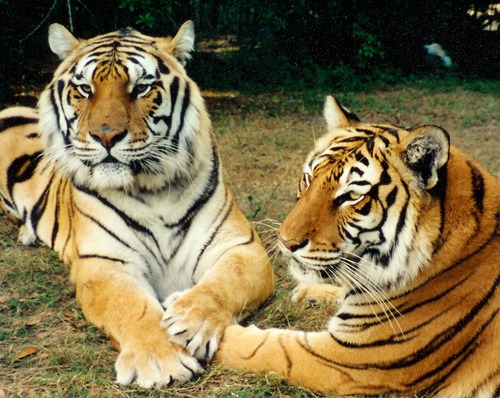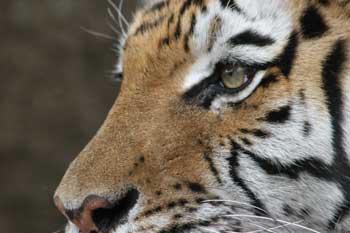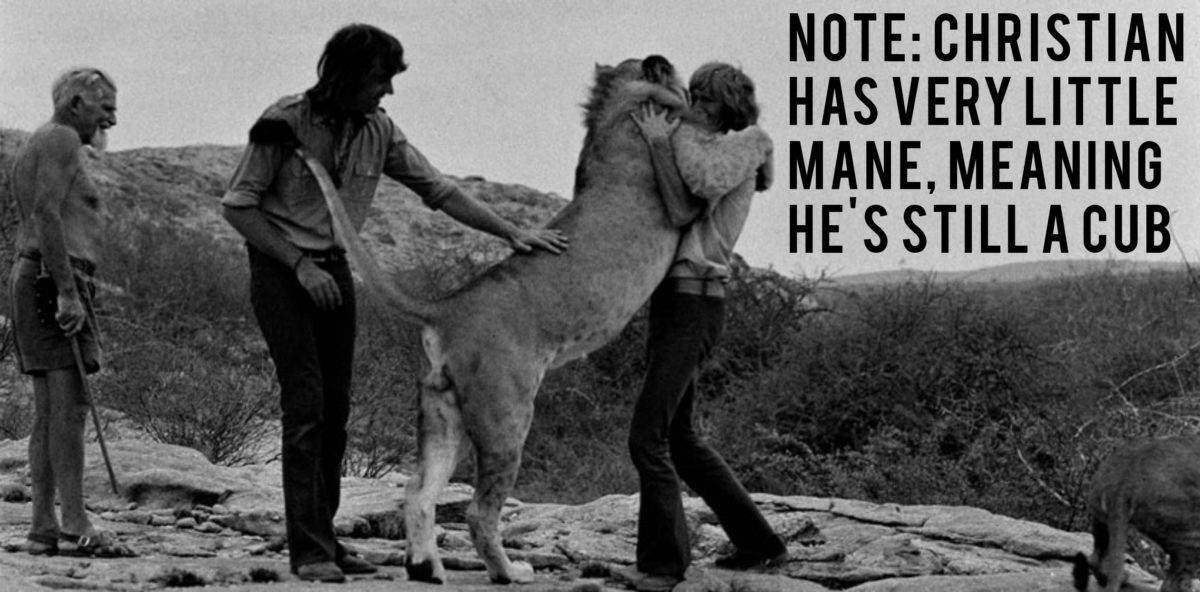International Tiger Coalition
International Tiger Coalition
 Top 10 Tiger Facts
Top 10 Tiger Facts
1. Poaching of tigers and their prey is driving decreases in tiger populations throughout their range, along with poaching of their prey and degradation of their habitat.
2. Inadequate law enforcement and residual demand for tiger products pose the greatest near-term threats to the survival of wild tigers.
3. Even talk of reopening trade in farmed (or captive-bred) tiger products has helped sustain residual demand, prompted investors to stockpile tiger skins and bones, and caused police in some Asian countries to take tiger trafficking less seriously.
4. Tiger farms (and other Intensive tiger breeding operations) must be phased out immediately while, at the same time, intelligence-led wildlife law enforcement and demand-reduction campaigns are intensified.
5. Demand reduction campaigns do work, but they have not yet been given adequate support to do so.
6. Intelligence-led law enforcement does work, but it has not been given adequate support to do so.
7. Governments should provide urgently needed support to increase capacity of national, regional and international law enforcement and intelligence exchange mechanisms, especially the coordinating capacities of INTERPOL, the CITES Secretariat and the World Customs Organization.
8. To increase the likelihood to stopping tiger trade from all sources, national, regional and international wildlife law enforcement agencies should compile and share with one another all information on tiger crime.
9. The number of tigers on China’s tiger farms alone has surpassed 6,000, while similar intensive tiger breeding operations are starting up in Southeast Asia. Investors in these farms depend on demand for tiger parts and products to increase. In fact, if wild tigers go extinct, these investors will enjoy a monopoly for supplying tiger-bone wine and tiger skins to China and, perhaps, the world.
10. Registration systems for intensive tiger breeding operations, including those using DNA, will not reduce demand for tiger products. Tiger farms and other intensive tiger breeding operations must be phased out to reduce this grave threat to wild tigers. The mere existence of these facilities sustains consumer demand.
11. China banned domestic tiger trade in 1993 because it was undermining the CITES ban on international tiger trade. The potential for domestic tiger trade in China to undermine CITES is now exponentially greater due to growth of human populations and per capita buying power.
12. The 2010 Chinese Year of the Tiger is offering unprecedented opportunities for policymakers in Asia and around the world to take action to bring back wild tigers. If they do not take immediate and bold new action, there may be no wild tigers left when the Year of the Tiger comes around again in 12 years.
13. Concern for saving “face” among tiger range and consuming counties should not supersede discussing “sensitive” issues that must be addressed if the world is to avoid losing wild tigers.
14. Wild tigers are emblematic of all of nature’s abundance (species and ecosystems) now endangered by degradation and overexploitation. People say, ‘when tigers disappear, forest fall,’ which robs people of livelihoods, food, water and health security.
Other important links include:
CITES Res. Conf. 12.5
CITES Dec. 14.69 Which states: Decision Directed to the Parties, especially Appendix-I Asian big cat range States: Parties with intensive operations breeding tigers on a commercial scale shall implement measures to restrict the captive population to a level supportive only to conserving wild tigers; tigers should not be bred for trade in their parts and derivatives.
(The way I read this, the U.S. should immediately stop the commercial breeding of Asian big cats for cub petting operations, as those serve no role in conserving wild tigers. Still, years after agreeing to this measure, the USDA and USFWS have failed to protect tigers and other big cats from exploitation for pay to play schemes.)
EU proposal to amend 12.5 at CITES CoP15
China’s CoP14 report on tigers
New EIA report on tiger trade in China
 “If we can’t save the tiger from extinction, we can’t save anything!” was repeated in a myriad of ways over the past week in Washington, DC by conservation experts from around the world. Einstein’s definition of insanity is to do the same thing, over and over and expect a different result. That has been “conservation as usual” to use the slang bantered about at this two day event that has been formally described as, “The most important conservation initiative undertaken in the history of the world to conserve wild tigers.” What makes this initiative unlike all of the past programs is two fold. 39 major conservation groups, including Big Cat Rescue, have joined forces with one common goal: Save the tiger in the wild. There have been other joint efforts, but none this large and never before has an entity as powerful as the World Bank been a committed partner in saving wild places for wild animals.
“If we can’t save the tiger from extinction, we can’t save anything!” was repeated in a myriad of ways over the past week in Washington, DC by conservation experts from around the world. Einstein’s definition of insanity is to do the same thing, over and over and expect a different result. That has been “conservation as usual” to use the slang bantered about at this two day event that has been formally described as, “The most important conservation initiative undertaken in the history of the world to conserve wild tigers.” What makes this initiative unlike all of the past programs is two fold. 39 major conservation groups, including Big Cat Rescue, have joined forces with one common goal: Save the tiger in the wild. There have been other joint efforts, but none this large and never before has an entity as powerful as the World Bank been a committed partner in saving wild places for wild animals.
Harrison Ford, one of Hollywood’s hottest actors, thanks to his latest Indiana Jones movie breaking records in theaters, is on the board of Conservation International and spoke at the June 9th launch. Also in attendance were our friend, the beautiful Bo Derek, who won the Wildlife Guardian Award at the Fur Ball last year, and Robert Duvall. HSUS brought Tiger Kids to the launch and this photo is from their participation as a ITC members. See these celebrities up close and purrsonal in the most important roles of their lives in this video we shot and find out more about how the World Bank and the International Tiger Coalition plan to save the tiger.
Big Cat Rescue has been accepted into the International Tiger Coalition based upon our unique ability to address the captive issues that imperil tigers in the wild. We keep the most accurate and up to date information on tigers in captivity, from attacks, maulings and escapes to proper care for tigers who have been bred for life in cages. We will be working with the team members of the International Tiger Coalition to stop the private possession and trafficking in tigers through better laws.
The US is the 2nd largest consumer of tiger parts. As China continues to defy world policy on tiger protection through their determination to farm tigers for their parts, it would create a legal market in China for tiger bones, organs and skins. When tigers are bred for photo opportunities in the US they outgrow their usefulness in just a few short months. If the trade of tigers in China is legalized, it gives US breeders a loop hole to sell their babies into slaughterhouse situations. While such slaughter is illegal in the US it is easy for those, who are so unscrupulous as to breed tigers in the first place, to exploit.
This is how they do it:
There is no cooperation between states to track tiger movement. Those who wish to exploit this lack of governance will license themselves in two states. Each state only cares about what happens in their own jurisdiction. Once the cat crosses a state line, no one is tracking what happens next. That way they can quietly disappear. This is why people in the industry are trying so hard to stop federal laws that would require them to be accountable from birth to death.
If a cat is owned by someone in one state, who is also licensed in a second state, and they want to get rid of the cat, all they have to do is tell the state where the cat is currently located that they are sending him to their out of state facility. USDA only tracks movement of tigers (sporadically) from one owner to another and not within the same ownership, even if in two different states. No one in the other state is alerted that the cat should be arriving and typically never does. This is how the the worst of the abusers bury the trail with the cat.
If big cat breeders and dealers will use a cub and shoot them when they are through it only stands to reason that they would leap at the opportunity to sell the tiger into underground slaughterhouses. Help Big Cat Rescue and the International Tiger Coalition put an end to tiger farming.
Who Cares About Tigers?
The International Tiger Coalition is an alliance of many organizations representing more than 40 organizations across the globe, united under the common aim of stopping trade in tiger parts and products from all sources. Members include:
American College of Traditional Chinese Medicine
Association of Zoos & Aquariums
Born Free USA (now part of API)
British and Irish Association of Zoos & Aquariums
Care for the Wild International
Council of Colleges of Acupuncture and Oriental Medicine
David Shepherd Wildlife Foundation
Environmental Investigation Agency
Global Tiger Patrol
Humane Society of the United States
International Fund for Animal Welfare
FREELAND
Save The Tiger Fund
Wildlife Alliance
Wildlife Conservation Nepal
Wildlife Protection Society of India
World Association of Zoos & Aquariums
World Society for the Protection of Animals
This unprecedented coalition, made up of environmental, zoo and animal protection organizations as well as the traditional Chinese medicine community, has come together to speak with one voice in calling for an end to trade in tiger parts and products through increased intelligence-led law enforcement and strengthening existing tiger-trade bans. Furthermore, the coalition joins leaders of the international traditional Chinese medicine industry in asking China to make its successful 14-year tiger-trade ban permanent.
Read the Ten in Ten Plan to save 10,000 tigers in the wild in 10 years HERE and see how you can help.
See a slideshow of tigers at Big Cat Rescue HERE
Get the 60 page report by TRAFFIC on the role of the U.S. Captive tigers in the trade of tiger parts HERE
The aim of the coalition is to coordinate research, communications and awareness-raising efforts in order to provide an organized response to the organized crime that sustains illegal tiger trade and endangers all wild tigers. www.endtigertrade.org
Timeline of the International Tiger Coalition
 A loose coalition of NGO’s began working together in 2007 and had achieved some unprecedented goals by 2009 when Big Cat Rescue joined the coalition.
A loose coalition of NGO’s began working together in 2007 and had achieved some unprecedented goals by 2009 when Big Cat Rescue joined the coalition.
2009 Big Cat Rescue attended the launch of the World Bank’s involvement in Washington, D.C. which was emceed by Harrison Ford and attended by Bo Derek and Robert Duvall.
2010 Big Cat Rescue sponsored the ITC booth at CITES and sponsored the attendance of the ITC Moderator, Judy Mills at the Tiger Summit in St. Petersburg, Russia.
2010 Big Cat Rescue sponsored the International Tiger Coalition booth in Doha, Qatar thanks to your votes for us in the Chase contest where we won $25,000. Your votes help save tigers!
2011 Big Cat Rescue made introductions to the members of the ITC to form the Big Cat Coalition.
2016 Presentation in Washington, DC
Broadcast live streaming video on Ustream
Letter to CITES Standing Committee
Open Letter to Participants in the 58th Meeting of the CITES Standing Committee Get the PDF
June 24, 2009
From the 40 Member Organizations of the International Tiger Coalition Re: Response to Notification to the Parties Number 2008/059 on Tiger Breeding Operations
In 2007, the CITES Parties agreed by consensus that “Parties with intensive operations breeding tigers on a commercial scale shall implement measures to restrict the captive population to a level supportive only to conserving wild tigers; tigers should not be bred for trade in their parts and derivatives.” (Decision 14.69)
In 2008, the CITES Standing Committee decided to ask relevant Parties to report on implementation of Decision 14.69. To this end, the Standing Committee established a working group to assist the CITES Secretariat in developing language for a Notification to the Parties requesting reports, with specific content, from relevant Parties.
Notification number 2008/059, issued on October 8, 2008, asked relevant Parties to report on their implementation of Decision 14.69, specifically:
a) the establishment of a national individual animal registration process incorporating a marking system;
b) the segregation of sexes to prevent further breeding;
c) the development of a strategic plan for the phasing-out of intensive breeding operations on a commercial scale or their conversion to operations devoted solely to the conservation of tigers; and,
d) the development of a policy with regard to what will happen to tigers currently in intensive breeding operations.
The undersigned 40 members of the International Tiger Coalition (ITC) are concerned that no country to which this Notification applies has responded meaningfully, i.e. with the information requested by the Standing Committee.
The only Party to respond at all was China. The ITC welcomes the fact that China responded.
However, Chinese authorities did not report specifically on their implementation of Decision 14.69 and did not address the four aforementioned issues specified in the Notification. Furthermore, the ITC is disappointed that other relevant Parties did not respond to the Notification in any form.
The ITC urges the Standing Committee to mandate the CITES Secretariat to take all appropriate measures to verify progress by relevant Parties to implement Decision 14.69, and to take appropriate steps if reports are not forthcoming within 90 days of the 58th Standing Committee meeting (SC58). Measures should include sending a delegation to relevant countries to assess their actions to implement the Decision and reporting to the next Standing Committee meeting, directly before the next meeting of the Conference of the Parties. The ITC also calls for donors to support such missions.
CITES Parties have endorsed the view that tiger farming for commercial purposes is a threat to the survival of wild tigers and needs to be stopped. We urge the Standing Committee, the CITES Secretariat and all relevant Parties to ensure full implementation of Decision 14.69 and full reporting on progress towards doing so as requested under the Notification. The CITES Parties were unanimous at CoP14 in their concerns for the future of wild tigers. That future requires a serious and timely response to this critical issue.
We thank you for your consideration,
International Tiger Coalition
American College of Traditional Chinese Medicine
AMUR
Animal Welfare Institute
Wildlife Trust of India
Animals Asia Foundation
Association of Zoos & Aquariums
Big Cat Rescue
Born Free Foundation
Born Free USA
British and Irish Association of Zoos & Aquariums
Care for the Wild International
Conservation International
Council of Colleges of Acupuncture and Oriental Medicine
David Shepherd Wildlife Foundation
Education for Nature – Vietnam
Environmental Investigation Agency
FREELAND
Global Tiger Patrol
Humane Society International
Humane Society of the United States
International Fund for Animal Welfare
Phoenix Fund
Pro Fauna Indonesia
Save The Tiger Fund
Species Survival Network
The Tigris Foundation
Tour Operators for Tigers
TRAFFIC
21st Century Tiger
WildAid
Wild Cat Conservation Legal Aid Society
Wildlife Conservation Nepal
Wildlife Conservation Society
Wildlife Trust of India
Wildlife Watch Group
World Association of Zoos @ Acquariums
World Society for the Protection of Animals
World Wildlife Fund
Zoological Society of London







I am leaving this comment because I am looking for advice. I visit Playa del Carmen Mexico quite often and have tried to get WWF to do something about the big cat abuse that I see there. This Wildlife organization doesn’t seem to be interested in Big cats this year it’s all about the Elephant apparently. I observed a lion cub being handled and passed around with out much of a reaction. I asked the abuser what they were giving this animal in order to keep it so lethargic. He responded with he’s just tired. I also observed this cub had conjunctivitis and didn’t look well. How do I have to hound to get these people shut down? There are a lot more where these degenerate people come from. Please any advice or information would be greatly appreciate. I have also decided to move my donation’s to another organization.
Brutal treatment and killing of tigers in tiger farms is outrageous. China and other nations cannot justify this.